Product development, testing and production control is carried out by B.Well Swiss AG, Switzerland. The Swiss control system used guarantees the high quality, longevity and safety of the entire B.Well product family.

- Bykov insoles
- Supinator insoles
- Orthoses: how to choose the right prescription?
- How to choose orthopedic insoles
- How to choose orthotics for flat feet?
- How to choose insoles for transverse flatfoot?
- Longitudinal arch flatfoot: Which insoles are needed?
- B. Fountain
- How do I choose?
- Wearing habits
- Benefits of orthopedic insoles for flat feet
- Carcass midsole
- indications
- Cantilevered half shells
- Insoles for formal and other shoes.
- Frameless insoles for low heel shoes
- Cantilever midsole for modeling shoes
- Cushioning in high-heeled shoes.
- How do I choose orthotics for adults with flat feet?
- Opinions of doctors about insoles for flat feet for adults
- Which type of orthoses are best for children: custom-made or mass-produced?
- How to choose orthotics for your child
- Types of insoles and materials used
- How to choose insoles for shoes – expert advice
- How to choose orthopedic shoes?
- What about deposits?
Bykov insoles
In the arsenal of aids for the prevention and prevention of foot diseases, Bykov insoles are the undisputed leader. They not only prevent the appearance of flat feet, but also help eliminate the associated deformities such as foot pain, swelling and awkward gait. We offer progressive supinators - effective aids for safe walking.
At first glance, flat feet seem like a minor problem. Many people only know about this condition through hearsay. We know from the time of compulsory military service that flat feet were not accepted in the army. If you encounter a person who has irregularly worn shoes and flaps their arms vigorously while walking, suspect flat feet.
In reality the condition is much more serious. It can be triggered by occupational activity, polio, ankle injuries, foot trauma, clubfoot, rickets or ill-fitting footwear.
Vitaly Bykov, PhD, invented 'first aid' for the deformed foot. The Bykov insoles named after him are known in 8 countries around the world and promote a new approach to the prevention of flat feet.
Previously, doctors suggested using insoles embedded in shoes to raise the flattened arch of the foot. Buying Bykov insoles and low shoes means stocking up on a kind of trainer that not only helps sick feet, but also trains healthy feet.
The product owes its creation to the author and the Yekaterinburg company NPF Supine Half-Soles. The production of the insoles is protected by a patent issued in Russia, meets the requirements of the Sanitary and Epidemiological Station, is recommended by the Ural Research Institute of Traumatology and Orthopedics and guarantees comfortable walking for at least a year.
From us you can buy Supinator insoles, the price of which is significantly lower than similar imported products. In addition, Bykov's orthoses are the best Russian version, which has received multiple diploma awards. The inventor himself was awarded the medal 'For Achievements in Scientific and Technical Creation' by the All-Russian Exhibition Center in 2007.
Supinator insoles
Who should buy and wear supinators and why? Primarily people who want to overcome musculoskeletal 'setbacks'. High-quality Supinator insoles contribute to correct gait, reducing leg and back pain, improving health and well-being.
In medical practice, supinating insoles are used to eliminate painful areas of static flat feet. Pain in the middle of the arch of the foot, under the ankles, in the lower leg muscles as well as in the knees and hips, hip overpronation and pain in the lower back with compensatory increased lordosis can be prevented with Bykov insoles.
We recommend purchasing insoles for beginning flat feet. They relieve pressure on the arch of the foot when walking and standing by raising the arch and elevating the inner edge of the foot.
The cost of the cushioning insoles is justified by the innovative elastic-rigid construction, which stimulates the muscles and ligaments to work. Buying an elastic insole is tantamount to buying a trainer that stimulates all elements of the foot to work. This normalizes blood circulation, increases intracellular metabolic processes, increases stability and reduces fatigue.
In addition, both the Bykov insoles and the half-soles massage the sole in a certain way and help improve the microclimate in the shoe. In contrast to plastic inserts, products made from natural grape seeds offer maximum comfort. Once the insoles are inserted into comfortable and fitting shoes, walking becomes a natural exercise, preventing foot deformities and ensuring correct posture.
Based on the recommendations of renowned doctors (Dr. Lavrukov and others), we recommend purchasing and using Bykov insoles:
- Individuals with a hereditary predisposition to developing foot deformities;
- People who strain their feet due to work or household chores;
- People who work standing and who are not prepared for sitting tasks;
- People who like to wear inappropriate footwear;
- people who are overweight;
- People whose muscle strength declines due to physical aging;
- in advanced cases of flat feet in combination with other methods;
- pregnant women;
- People suffering from varicose veins of the lower limbs.
Orthoses: how to choose the right prescription?
In order to make the right choice, it is important to know for what purpose orthoses are purchased and what they are made of. Three main purposes can be distinguished:
 In favor of
In favor of  Unavailable
Unavailable
 Add to favorites
Add to favorites  Unavailable
Unavailable
 Locked in
Locked in  Not available
Not available
How to choose orthopedic insoles
When selecting insoles, the main factors to consider are foot size and intended use. Errors in sizing can result in reduced or no positive effect, so the patient must know how to choose the right insole. It should fit snugly in the shoe without slipping or creasing when walking.
Before choosing an insole, it is essential to consult a doctor. Based on the complaints, examination and tests, the specialist will select the right type. All the patient needs to do is determine the appropriate price range and design.
How to choose orthotics for flat feet?
It is important to know the different types of complaints:
Depending on the type of complaint, a specific type of insole is selected.
How to choose insoles for transverse flatfoot?
This form of flat foot has three levels of severity. In the first degree, the big toe tilts slightly to the side and a stage occurs where a lump forms on the bone. The second degree occurs when the big toe has a significant angle of curvature (35 degrees). The third degree occurs when all fingers are deformed.
There are several parameters that answer the question of how to choose insoles for this type of flat feet. They should be equipped with a pelota or metatarsal insole. It supports the transverse arch. This reduces the strain and relieves the pain.
Longitudinal arch flatfoot: Which insoles are needed?
This form of flat foot can cause a variety of problems, such as knee pain, joint pain, varicose veins and poor posture.
How to choose insoles for an adult with a longitudinal foot? In this case, the doctor prescribes the mandatory presence of a spinator in the insole. It ensures that the load is evenly distributed across the foot, helping to reduce pain and discomfort. The usual material for these insoles is a high-temperature-resistant plastic that supports the heel and arch of the foot.
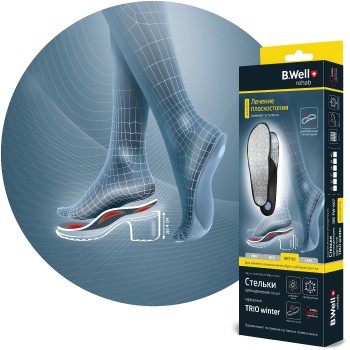
Orthopedic frame insoles, winter
![]()
![]()
![]()
![]()
![]()
![]()
![]()
![]()
![]()
![]()
![]()
Provides comfort in direct contact with the skin of the foot and helps maintain healthy foot skin.
The soft padding relieves pressure on the sensitive areas of the foot and relieves pain in the heel area.
Ergonomic insole made of soft polymer foam gently supports the inner longitudinal and transverse arch of the foot, balancing the biodynamics of the step
Anatomical frame made of hard special resin with increased flexibility supports the inner and outer longitudinal arch of the foot
The flexible anatomical frame made of special resin precisely supports the inner and outer longitudinal arch of the foot, contributing to the correct development of the biodynamics of the step.
A soft polymer foam metatarsal pad relieves pressure on the toes and keeps them in the correct position.
B. Fountain
We have simplified the selection of products by dividing them into PRO, MED, ORTHO and CARE. So everyone can find the right product for their needs!
you feel easy walking i Prevention of transverse flat feet UNO insoles and half insoles. They are a solution for open and closed shoes and are also suitable for high-heeled shoes.
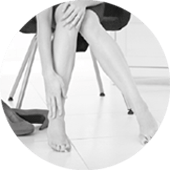
The DUO range of pads and half pads for children and adults can help in the treatment of combined forefoot/lateral flatfoot.. DUO insoles support the arch of the foot, align the joints and prevent the development of clubfoot in children.

The CARE line is gentle care for your feet. The products in this line are intended for people who need special, gentle care, especially during the preparation period or rehabilitation after surgical procedures.

TRIO insoles and half insoles with particularly hard-wearing padding help Chronic foot problems. By supporting the arch of the foot in longitudinal and transverse flatfoot, aligning the heel and joints of the lower limbs and spine, TRIO insoles provide the necessary walking comfort and reduce pain syndrome.

Nearly 80% of the population population suffers flat feet. Flat feet are four times more common in women than in men.
The most common cause of flat feet is weakened muscles in the foot and lower leg, as well as weakened bones and ligaments.
Overweight, uncomfortable shoes, standing work, Lack of necessary physical activity can lead to foot deformities and, as a result, the development of flat feet.
Foot problems can also be influenced by wearing high-heeled shoes. High heels or with a narrow toe box.
How do I choose?
To choose the right orthopedic accessories, it is advisable to visit a podiatrist or a specialist store. Only a professional can help you choose the right size for your condition. Simply wearing it incorrectly can cause damage to the entire body, as gait disorders increase the strain on the spine. Specialized facilities offer custom-made orthotics tailored to your size and problems.
For modeling and wide shoes, the insoles will be different. It is advisable to remove the standard insert to attach it. The standard insert should not be left in place. The foot will feel uncomfortable and blisters or corns will appear. Once the orthotics are in place, walk around the room to identify any problems or discomfort. Continue until the patient feels comfortable.
Wearing habits
It is important to know that for successful treatment of hip coxarthrosis and other types of arthrosis, it is important not only to choose the right insoles, but also to use them correctly. Initially, the patient may experience some discomfort due to the changed position of the arch of the foot and the relief of pressure on the joints. Orthotics should be used throughout lower limb arthritis treatment and at home. To extend the life of products, general rules should be followed:
- Ideally, the insoles should be removed from shoes daily to check for damage or wear.
- Wash or clean shoes only by hand.
- When washing, use a soap solution, not powder.
- Allow the shoes to dry on a flat, level surface.
Benefits of orthopedic insoles for flat feet
◉ Practically invisible in barefoot shoes.
Does not take up any space in the toe area of the forefoot.
No movement in the shoe thanks to the adhesive fastening.
Carcass midsole
The equivalent of full sole padded insoles with cushioning under the heel. Suitable for shoes with a maximum heel height of four centimeters.
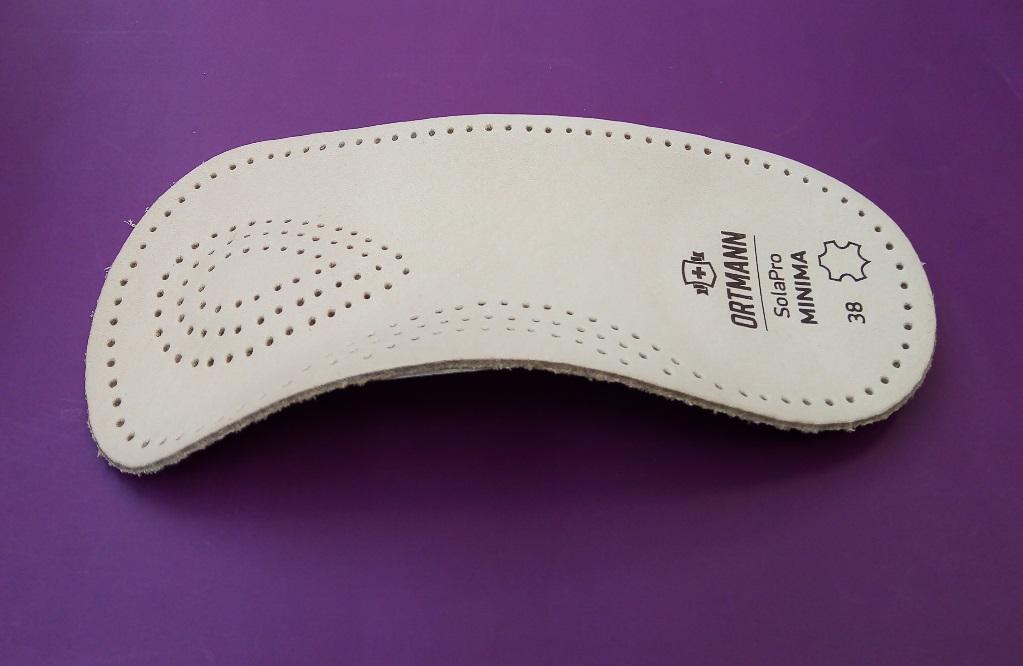
The carcass is made of durable plastic that adapts to the anatomical curves of the foot. The frame is covered with leather on the top. Moisture exchange and ventilation in the midsole are good.
The metatarsal inlay and the carcass, which can be adjusted in longitudinal flexion, properly support the foot. The padding cushions the stress on the joints of the foot.
The frame remains dimensionally stable even under heavy loads. Adult sizes from 35 to 46.
indications
Non-sunken longitudinal feet in grades 1 to 3
Cantilevered half shells
Cantilevered half shells are more flexible. This makes them suitable for high heels. Depending on the shape, size and position of the footbed.
Insoles for formal and other shoes.
This insert combines longitudinal and transverse arch support.
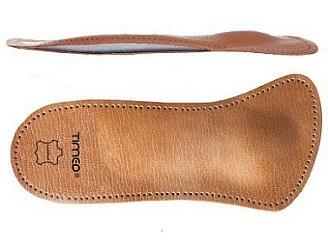
Frameless insoles for low heel shoes
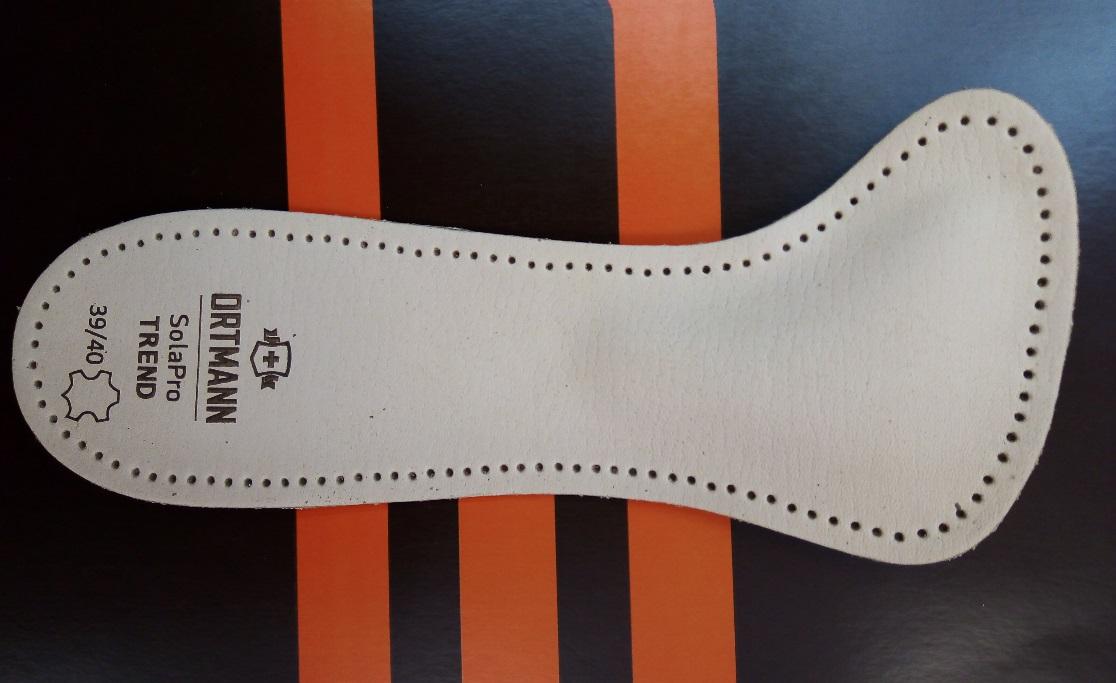
The cross support in this shoe is T-shaped. It is wider and longer than the previous type. This is justified because the foot needs more support in the metatarsal area when moving upwards in the heel area.
◍ Prevention of pain when wearing high heels
◍ Flattened forefoot.
◍ Transverse flat feet.
◍ Curved toes.
◍ Prevention of flat feet
Cantilever midsole for modeling shoes
Comes with an adhesive backing that prevents the midsole from moving inside the shoe. Suitable for shoes with a wedge or a heel of 5-7 cm.

The wide T-strap provides excellent transverse arch support. It makes walking more comfortable despite the heel.
In open models, the midsole is not visible from the side. This is very practical in summer in sandals.
◎ Transverse flat feet.
◎ varices
Cushioning in high-heeled shoes.
The padding in unstructured midsoles prevents pressure from building up in the instep area. This prevents corns and pain when walking.
How do I choose orthotics for adults with flat feet?
Before you decide on insoles, you should consult your doctor. Your doctor will consider the following criteria:
In the case of transverse flatfoot, when the deformity is in the toe area, the insoles should have a pelota (a protuberance to evenly load the foot) or a metatarsal pad (a special elevation to support the transverse arch).
For longitudinal flat feet, in which the arch of the foot changes at the inner edge, insoles with supinators are preferred 3.
For mixed flat feet, insoles made of rigid material or a carcass with an insole, heel cushion and supinator are suitable.
In the early stages of flat feet and small foot deformities, prophylactic insoles with special basins and cushioning are suitable. The age, lifestyle and health status of the person affected should be taken into account..
The insole must fit tightly into the shoe, otherwise it will have little effect and reduce the space in the shoe. Such narrow shoes can be tight when an orthopedic insole is inserted.
With some anatomical features of the foot, it is difficult to find a therapeutic insole. In such cases, they can be made individually based on an impression made by a podiatrist.

Opinions of doctors about insoles for flat feet for adults
– The foot – it is the basis, the foundation of the musculoskeletal system, which not only influences the joints, the spine and other organs, but also brain activity, explains the the orthopedist and traumatologist Vasiliy Yertskin. – The foot deformity deforms the entire musculoskeletal system, which leads to muscle displacements, narrowing of blood vessels and nerves – all the way to the cervical spine and head. This in turn can lead to impaired blood circulation and the conduction of nerve impulses, the development of headaches, reduced attention and concentration, and irritability. The condition of the foot is therefore very important for the development of optimal health, and orthoses play a major role in this.
This should be taken care of from childhood. Today, one in two children has some type of foot deformity, which can later lead to flat feet and other problems. I therefore recommend prophylactic orthopedic insoles made of a special soft material, which are selected after a thorough diagnosis and assessment of the foot.
I believe (and have tested it myself) that properly fitted insoles are essential for every adult, even if they do not have a foot deformity, let alone severe flat feet. They can be worn from the age of 25, because at this age around 65 of the population already suffer from one or another deformity. The most important thing is that you choose the insoles with the help of a doctor.
The most common misconception is that you can wear insoles for a few years and your flat feet will go away. That's not the case. Orthotics should be worn permanently and for life and should be corrected or replaced regularly. This is the best option for musculoskeletal preservation.
Which type of orthoses are best for children: custom-made or mass-produced?
Creating a private product is an acceptable way to address a patient's specific problems. The technology can be different. For example, an impression is made from so-called biofoam, which has a memory, or shapes are heated and bent to suit individual parameters.
Factory products are standard products and are not always suitable for the individual foot. The problem is compounded when you choose your own product without seeking advice from a professional. However, if these rules are followed, the purchase will be cheaper. Purchased variants are cheaper in terms of distribution and price.
Here all rollers and depressions are adjusted according to the patient's age, the condition of the musculoskeletal system and the length and width of the foot.

How to choose orthotics for your child
- It is strictly forbidden to buy a few sizes too big (as is common in the 'outgrowing' category) to avoid deterioration;
- The shoe itself into which the orthosis is inserted must not be too small;
- it is advisable to purchase with the child/teenager or to have your own copy of the orthosis in the current size;
- it is advisable to always buy from the same manufacturer, which comes with a discount (OrthoPanda offers this advantage).
Such products are very important because if you identify the problems at a young age and correct them, you can get a good result. More precisely, it is about correction. Once the foot is fully developed (at the age of 14-15), this is no longer possible. After that, it's just a matter of stopping the deformation and maintaining the normal state of the bone structures. The difficulty in choosing such products is that children's feet grow very quickly.
Types of insoles and materials used
In general, shoe insoles are divided into the following groups
- individually – are made to order based on the customer's specific problem and the peculiarities of the limb structure;
- factory manufactured – ready-made products that contain all the necessary medical components and reduce the level of stress;
- modifiable models – Orthoses in which certain components can be adapted to the needs of the user.
The main materials used for insoles are leather, suede and suede. These materials are practically wear-resistant. Recently, models made of silicone have become very popular. They adapt well to the curvature of the foot and have less elasticity.
How to choose insoles for shoes – expert advice
All products have good cushioning properties and a slightly massaging effect. But even good insoles that are poorly chosen have no positive effect. When choosing a model, consider the following basic principles
- The product must fit perfectly;
- It should conform to the contour of the shoe being worn and lie flat on the bottom of the shoe;
- For certain types of flat feet, products with a pad should be chosen;
- For minor problems, anatomically shaped insoles are recommended;
- Pay attention to the material of the product. Experts recommend choosing leather products or models made from polymeric materials.
If the insoles are not fitted properly, you will feel uncomfortable when walking and the pain will not go away. That is why it is so important to entrust the choice of a product to a professional who will take into account all your specifics and wishes.
How to choose orthopedic shoes?
It is best to first consult a doctor so that he can make a diagnosis and personally recommend a specific footwear, because depending on the pathology, the parameters of the shoes are different. For example, some need a soft shoe while others need a moderately stiff shoe. However, they all need arch support. In order to avoid aggravation of the situation, a specialist should be consulted.
Suitable shoes are usually sold in a specialist store. In some cases you have to have them custom made, but that doesn't happen often, for example in rare cases of rheumatoid arthritis, where everyone's foot deforms in their own way.
What about deposits?
Specially made insoles are placed in shoes instead of normal insoles (and in all types of shoes, not necessarily orthopedic ones). They also provide cushioning and arch support. They help with many problems such as flat feet (but not in all cases), joint deformities of the lower limbs and back pain.
There are three types of flat feet: longitudinal, transverse and combined flat feet. In longitudinal flatfoot, the distance from the base of the big toe to the heel is reduced; in transverse flatfoot, the distance from the base of the big toe to the little toe is flattened. The third type is combined flatfoot. It occurs when both arches of the feet are deformed.
By the way, this can be clearly seen from the footprint. For curiosity's sake, you can put your wet foot on the floor after showering and examine the footprint. Normally the internal parts should form a noticeable arch. With flat feet, the foot is completely pressed against the ground.
Flat feet are very common in obesity and diabetes, as well as foot and ankle injuries.
Read more:- Transverse orthopedic insoles.
- Insoles are suitable for.
- orthopedic insoles.
- Manufacture of orthopedic insoles for children.
- Equipment for manufacturing orthopedic insoles.
- Orthopedic sports insoles for running.
- Insoles for valgus in adults.
- Personalized media inserts.
